 |
 |
 |
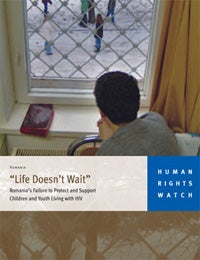 |
“Life Doesn’t Wait: Romania’s Failure to Protect and Support Children and Youth Living with HIV” Romania: July, 2006 Thousands of Romanian children and youth living with HIV face widespread discrimination that keeps many from attending school, obtaining necessary medical care, working, or even learning about their disease. Currently, more than 7,200 Romanian children and youth are living with HIV. The vast majority were infected between 1986 and 1991 as a direct result of government policies that exposed them to contaminated needles and “microtransfusions” of unscreened blood. Forty percent of these children are not attending any form of schooling. Those who do risk ostracism, abuse by teachers and other students, and expulsion if their HIV status becomes known. Despite the Romanian government’s stated commitment to providing access to antiretroviral therapy, law and practice prevent children from receiving the resources they need to lead healthy and integrated lives. In order to protect the rights of children and youth living with HIV, laws and policies must be instituted that address this discrimination by ensuring confidentiality of HIV status and universal access to education and treatment. |
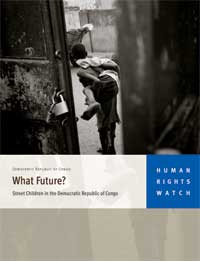 |
“What Future?: Street Children in the Democratic Republic of Congo” Democratic Republic of Congo: April 2006 As civil violence in the Democratic Republic of Congo rages on, tens of thousands of children have been forced onto the street, orphaned by a war that has killed some four million people. Without family or support, these children endure routine physical, emotional, and sexual abuse, as police, soldiers and civilians exploit their vulnerability and use them for illegal activities. These youngsters are routinely rounded up by police for nothing more than being without a home and are held for extended periods of time in overcrowded and unsanitary lockups. Children suffering from HIV/AIDS are particularly vulnerable to abuse, as extended family members often blame them for their parents’ death or accuse them of transmitting the disease through sorcery. In the face of ongoing violence, this cycle of abuse must be addressed |
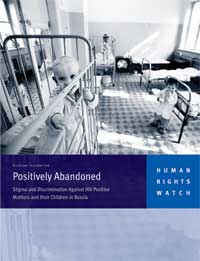 |
Russia: June 2005 Though Russia is home to one of the fastest-growing AIDS epidemics in the world, the Russian public is almost as unaware of HIV today as it was a decade ago, when the disease was scarcely heard of. Little action on the part of the government has resulted in a social shame so significant that those infected will go to extremes to hide it from friends, family or coworkers—often resulting in isolation. It is against this backdrop that a growing number of HIV-positive pregnant women have begun abandoning their babies. Shunned by society, vulnerable to discrimination and wary of the costs of raising a child, these women are leaving their children to be placed in specialized orphanages for HIV-positive children, or worse, warehoused in stark hospital wards. The quarantine of these children is illegal and discriminatory, but has become accepted in a society where fear and ignorance have created a vast social stigma. There are national and international standards that are supposed to protect the children of HIV-positive women, but the Russian government is failing to implement them. “They told us not to kiss our child and to keep a separate set of dishes.” |
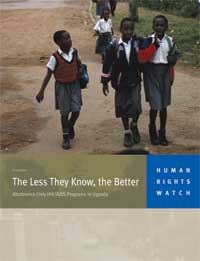 |
“The Less They Know, the Better: Abstinence-Only and HIV/AIDS Programs in Uganda” Uganda: March 2005 Long regarded as a global leader in the fight against HIV/AIDS, Uganda—with the support and funding of the Bush Administration—has begun shifting its HIV-prevention strategies for youth from scientifically proven community-based and comprehensive prevention approaches to ideologically driven abstinence-only programs. Despite a dramatic drop in Uganda’s HIV prevalence rates over the last decade, from 15 percent in 1992 to six percent in 2002, surveys show that more than half of Ugandan girls still have sex by the age of 17, often without the use of condoms. With new programs focused on “Abstinence and Being Faithful”—the title of a draft policy released by the Ugandan AIDS Commission in 2004—AIDS advocates fear that condoms may disappear from prevention campaigns altogether. Since the release of that draft, the government has taken such measures as removing HIV/AIDS materials from primary school circulation (replacing them with books emphasizing morals and heterosexual marriage) and revoking the funding of groups that promote condom use. If Uganda is to curb the raging HIV/AIDS epidemic, it must address these damaging policy changes and initiate new prevention efforts. |
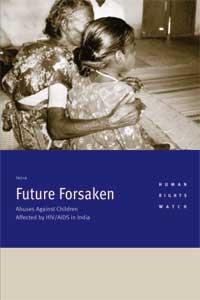 |
“Future Forsaken: Abuses against Children Affected by HIV/AIDS in India” India, July 2004 Hundreds of thousands of children in India are living with HIV/AIDS. Many more children are otherwise seriously affected by India’s burgeoning epidemic—when they are forced to withdraw from school to care for sick parents, are forced to work to replace their parents’ income, or are orphaned (losing one or both parents to AIDS). Yet HIV/AIDS-affected children, including those living with the disease, are nearly invisible in the Indian government’s policy response to the country’s devastating epidemic. Children affected by HIV/AIDS are being discriminated against in education and health services, denied care by orphanages, and pushed onto the streets and into the worst forms of child labor. Discrimination against girls makes them more vulnerable to HIV transmission and makes it more difficult for them to get care. Many children and the professionals who care for them are not getting the information about HIV they need to protect themselves or to combat discrimination. This report documents abuses against India’s HIV/AIDS-affected children and calls on the Indian government to recognize their plight and to take immediate action to protect them from discrimination and exploitation . “When I went to school, I sat separately from the other children, in the last mat. I sat alone. The other children wanted to be with me, but the teacher would tell them not to play with me. She said, ‘This disease will spread to you also, so do not play with her.” |
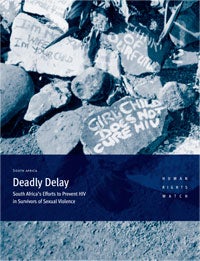 |
“Deadly Delay: South Africa's Efforts to Prevent HIV in Survivors of Sexual Violence” South Africa: March 2004 Sexual violence against women and girls in South Africa has been a problem of epidemic proportions. In a nation with the highest reported rate of HIV/AIDS in the world, this violence could be a death sentence. In 2002, the South African government took the important step of pledging to provide rape survivors with the short, affordable course of antiretroviral drugs known as post-exposure prophylaxis (PEP). If administered promptly, PEP can reduce the risk of HIV transmission. In a 2004 investigation, Human Rights Watch found that while this effort was a crucial step toward protecting women from the consequences of sexual violence, the government’s failure to provide adequate information or training about PEP left rape survivors and service providers without basic information about PEP. PEP was generally unavailable outside major urban centers. By law, children under 14 could not consent to medical treatment; while provisions existed to obtain proxy consent in cases where no parent or guardian could be reached, many health care staff did not know or did not follow them. Inadequate police response to rape complaints, coupled with health professionals’ insistence that rape survivors file a police report in order to receive services, also undermined survivors’ access to services. In pledging to provide PEP, South Africa took an important stride in protecting rape survivors from HIV/AIDS. But without measures to ensure its availability, these commitments have been compromised. “The hospital superintendent was scared to give the antiretrovirals because he thought it was against government policy. He got a protocol, but he had no drive from the government to help staff the program. I had to convince the hospital superintendent to start providing PEP [post-exposure prophylaxis].” |
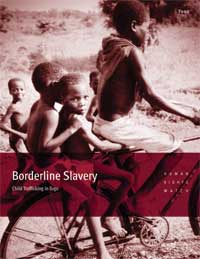 |
“Borderline Slavery: Child Trafficking in Togo” April 2003 Each year, thousands of West African children are trafficked from their homes and forced into hazardous and unpaid labor. Lured with promises of education, vocational training, paid employment, or material goods, these children find themselves brutally exploited in the fields, factories, markets and homes of many West African countries. In Togo, these children come from predominantly poor, agricultural backgrounds and have little schooling. In many cases, they are recruited after running out of money to pay for school, despite the guarantee of free primary education in Togo. Others are trafficked following the death of a parent, or as orphans. Many of these children take life-threatening journeys to countries outside of Togo, often by boat on the open sea. They describe brutal working conditions, beatings, death threats, and the prospect of never seeing their families again. Some who escape end up working in prostitution in Lomé, Togo’s capital, where they face HIV infection and other dangers. The government of Togo, its donors and the United Nations must address these abuses, which are in violation of international human rights law. “I was told she would be helping to sell candy... I wasn't sure how a four-year-old could help, but the woman said she needed help.” |
 |
“Suffering in Silence: Human Rights Abuses and HIV Transmission to Girls in Zambia” January 2003 In many countries in eastern and southern Africa, HIV prevalence among young girls is four to seven times higher than among boys the same age. In Zambia, tens of thousands of girls—many orphaned by AIDS or without parental care—suffered in silence as the government failed to provide basic protections from sexual assault. Assault of young girls in Zambia was widespread and complex: girls were often assaulted by family members or taken advantage of by male caretakers, and some girls were so impoverished that they had to trade sex for survival. Younger girls became extreme targets for abuse because of the false but widespread belief that sex with a virgin would cure AIDS. The subordinate social and legal status of women in Zambia made it difficult for them to negotiate safer sex or take steps to protect themselves from HIV infection. Human Rights Watch urged the Zambian government to take action to curb these abuses, particularly by placing pressure on the criminal justice system to deal appropriately with complaints of sexual assault. “I used to go to church, and I was raped by the priest.... I'm scared to tell the police; they won't believe me because he's a priest. I might have HIV/AIDS or STDs. It happened three months ago. I haven't had a period since then.” “If we don't get involved in the fight against HIV/AIDS, there will be no girls left to educate.” |
 |
September 2002 The Bush Administration has advocated hard for abstinence-only programs in the fight against HIV/AIDS. By portraying abstinence from sex until heterosexual marriage as the only acceptable behavior for youth, these programs deny adolescents basic information that could prevent the spread of sexually-transmitted diseases, including HIV/AIDS. By law, abstinence-only programs cannot “promote or endorse” condom use, nor provide HIV/AIDS information sensitive to the rights and needs of lesbian, gay, bisexual, and transgender youth. U.S. government-funded abstinence-only programs restricted teachers from providing complete, accurate information about HIV prevention, including information about using condoms to prevent HIV transmission; in some cases, teachers inaccurately told students that condoms were ineffective in preventing HIV transmission. The Bush administration has advocated for significant funding increases to support abstinence-only programs, notwithstanding the paucity of evidence that they work to delay adolescent sex, much less change the sexual behavior that puts adolescents at risk of HIV/AIDS. In addition, abstinence-only programs interfere with fundamental rights guaranteed by international law, including the right to “seek, receive and impart information and ideas of all kinds,” the right to nondiscrimination, and the right to the highest attainable standard of health “I don't know any other way but abstinence to prevent HIV.” |
 |
“In the Shadow of Death: HIV/AIDS and Children’s Rights in Kenya” June 2001 Kenya’s estimated one million orphans represent only a fraction of the children affected by AIDS in Kenya. Because HIV/AIDS so often impoverishes and stigmatizes the children it affects, these children were at high risk of ending up on the street or in other dangerous situations. AIDS-affected children faced many obstacles to staying in school, as many were forced to withdraw to care for a sick relative, or, oftentimes, to become breadwinners to replace a family member who had died from AIDS. In many cases they were further disadvantaged by the unscrupulous and unlawful appropriation of property they were entitled to inherit from their parents. These problems were compounded by poor access to information and education about HIV/AIDS. After many years of a weak official response to HIV/AIDS, the government of Kenya has begun to take aggressive measures to energize its fight against the disease, including the passage of legislation designed to facilitate the importation of cheaper, generic antiretroviral drugs and the first steps to removing tariffs on imported condoms. In this report, Human Rights Watch suggested that equally aggressive measures must be taken by the government to ensure protection of the rights of children affected by HIV/AIDS "I may have to go into prostitution, and then I know I will get HIV and die. I would rather have a real business, but it is not easy" |
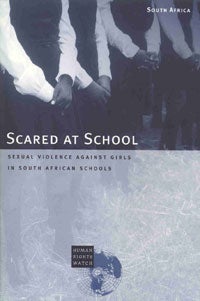 |
“Scared at School: Sexual Violence Against Girls in South African Schools” March 2001 South African schoolgirls of every race and class are being held back by sexual violence and harassment that impedes their right to education. Girls are raped in school bathrooms, in empty classrooms and hallways, and in hostels and dormitories. They are harassed, assaulted and verbally degraded by classmates and teachers. And with each act of sexual assault, these girls faced the possibility of contracting HIV—a virtual death sentence in a country that has witnessed more HIV/AIDS cases than any other country in the world. Moreover, school authorities concealed this violence and failed to take action against its perpetrators, while girls who reported abuse were often victimized to a greater degree. As a result, girls lost their educational rights, as many interrupted or left school because they felt unsafe, and others were required to cope with a deadly epidemic. Despite initial steps by the South African government toward recognizing that violent crime poses a threat to school safety, sexual violence was a significant hurdle to equal education and public health. Human Rights Watch called on the government to enforce a proactive, coordinated, and system-wide response, requiring national leadership and commitment at every level of the education system.
|
